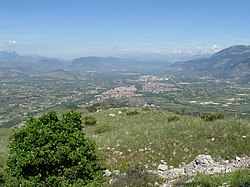Valle Peligna: Difference between revisions
m rm overlink, cleanup using AWB |
Niceguyedc (talk | contribs) m v1.38 - Repaired 1 link to disambiguation page - (You can help) - Sagittario |
||
| Line 5: | Line 5: | ||
The valley takes its name from the Greek term ''peline'', meaning "muddy": this refers to prehistoric times, when it was occupied by a lake which disappeared after a series of earthquakes (the former barrier between the lake and the sea was in what are now the gorges of [[Popoli]]), leaving the land full of marshes but fertile. Three hills near [[Sulmona]] are the relics of the single island in the lake. |
The valley takes its name from the Greek term ''peline'', meaning "muddy": this refers to prehistoric times, when it was occupied by a lake which disappeared after a series of earthquakes (the former barrier between the lake and the sea was in what are now the gorges of [[Popoli]]), leaving the land full of marshes but fertile. Three hills near [[Sulmona]] are the relics of the single island in the lake. |
||
It is crossed by the rivers [[Aterno]] and [[Sagittario]], and is bordered by the [[Fucino]] basin by east. Apart [[Sulmona]], the main centers in the plateau include [[Raiano]], [[Vittorito]], [[Corfinio]], [[Pratola Peligna]] and [[Pacentro]]. |
It is crossed by the rivers [[Aterno]] and [[Sagittario River|Sagittario]], and is bordered by the [[Fucino]] basin by east. Apart [[Sulmona]], the main centers in the plateau include [[Raiano]], [[Vittorito]], [[Corfinio]], [[Pratola Peligna]] and [[Pacentro]]. |
||
Historically, it was inhabited by the [[Paeligni]], a group of [[Pelasgic peoples|Pelasgians]] who came here from [[Asia Minor]] in the 12th century BC. |
Historically, it was inhabited by the [[Paeligni]], a group of [[Pelasgic peoples|Pelasgians]] who came here from [[Asia Minor]] in the 12th century BC. |
||
Revision as of 22:50, 24 May 2016

The Valle Peligna, also known as Conca di Sulmona, is a plateau in central Abruzzo, southern Italy, included in the province of L'Aquila. It has a surface of some 100 km².
The valley takes its name from the Greek term peline, meaning "muddy": this refers to prehistoric times, when it was occupied by a lake which disappeared after a series of earthquakes (the former barrier between the lake and the sea was in what are now the gorges of Popoli), leaving the land full of marshes but fertile. Three hills near Sulmona are the relics of the single island in the lake.
It is crossed by the rivers Aterno and Sagittario, and is bordered by the Fucino basin by east. Apart Sulmona, the main centers in the plateau include Raiano, Vittorito, Corfinio, Pratola Peligna and Pacentro.
Historically, it was inhabited by the Paeligni, a group of Pelasgians who came here from Asia Minor in the 12th century BC.
